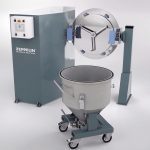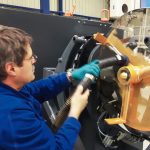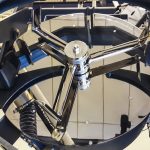Container mixers are all-purpose mixers particularly appreciated for their flexibility. Unlike stationary mixers, the mixing container is mobile and can be filled and emptied elsewhere if necessary. The system is therefore extremely flexible and the product remains in the same container throughout all the process steps – free of contamination, without separation during transport and with clear batch traceability. This is especially advantageous in case of frequent recipe changes. Zeppelin Plant Engineering, the leading manufacturer of mixing systems for the plastics, chemicals, masterbatch and food industries, has now come up with a new container mixer: the CMQ. This new mixer is based on the tried and tested CMS but with one important difference: the mixing head has been redesigned to reduce cleaning times.
Optimized design for best results
With other mixing systems, the mix is normally directed outwards and then to the upper edge of the container. This leads to pressing and hard-to-clean caking. The mixing tool is generally very large and the clearance from the bottom very small. The designers chose a different approach for the new CMQ. Dr. Stephan Poller, Business Unit Manager Mixing Technology at Zeppelin Plant Engineering in Kassel, explains the key concerns during the first stages of development: “We obviously thought about flattening the container for cleaning reasons. However, we were not too sure to begin with if pigment residues would accumulate at the seams of the bottom, since the mixer is turned upside down during mixing, and also at the lid. The turning point was the combination of the very flat bottom and the specially designed tool.” Various shapes were considered for selection initially, and the objective was not only to minimise cleaning times but also to achieve high dispersion, reduce the energy input and facilitate access.
The solution is a mixing tool with three specially designed wings that prevent pressing while still obtaining excellent mixing results. The engineers made use of elements from the field of aerodynamics for this purpose. The special aerofoil profile provides a suction effect that directs the material upwards, thereby achieving a high mixing efficiency without material pressing on the mixing head or on the walls of the container. The high lifting force ensures fast mixing (3 to 4 minutes) while the low mixing resistance results in lower energy input (up to 50 % less energy compared to the previous system) and the large clearance (up to 70 mm) between the tool and the bottom prevents material build-up. Thanks to this much larger bottom clearance and the suction effect, no pressure is generated on the surface of the mixing head and deposits are unable to form. Unwanted temperature increases are reduced to a minimum. Furthermore, a specially designed aspiration system was created to put an end to dust emissions after the docking process.
The developers have always aimed to optimise the mixing tool while taking fluid mechanics into account. However, the consistent application of aerodynamic laws for mixing bulk material has failed to have the desired effect until now. “Five to ten years ago, incorporating a new design into a mixing tool was much more complicated. Thanks to state of the art production processes and the fact that engineers can send their data directly to the machining centre, the transition from design to finished part is nowadays much easier”, Poller adds. It is also simpler to try out an unusual tool. It was not the mixing tool alone that led to the breakthrough, but rather the combination of a flat mixing head with the aerofoil profile tool. Together, they ensure a high lifting force, only minimal turbulence and low mixing resistance for fast and effective homogenisation plus a very good colour yield.
Hydraulic locking device
“Good cleanability on the inside of the mixer is naturally a priority for our customers, but we also wanted it to be easy to clean on the outside”, Poller explains. This is why the locking mechanism was redeveloped. During mixing, the locks have to withstand very high forces and generally require the use of large clamps to hold the mixing head onto the container. A hydraulic locking device now replaces these clamps. The advantage is that these elements are considerably smaller and much more straightforward to clean. Moreover, standard components can be used. All cables disappear inside a control box, which greatly simplifies cleaning of the entire exterior. What used to take twenty minutes to accomplish can now be done in two – or, as it were, a single wipe.
Another simplification is that in contrast to other mixers, the container is not centred on the floor but in the mixer itself. The floor guide rails that used to hinder maintenance and cleaning can now be dispensed with. The control system supplied by Zeppelin Plant Engineering is userfriendly and features a touch panel. As with the proven CMS series, discharge stations for loading, explosion protection, a safety fence or a light barrier can also be provided. The new CMQ container mixer can naturally be integrated into existing Zeppelin plants.
Outlook
The CMQ mixer will be available in various sizes, from 160 to 2000 l. Although Zeppelin Plant Engineering are currently working on the finishing touches – the first mixer should leave the factory in December – it has already attracted a lot of attention. “These days, companies that process masterbatches or pigments, particularly powder coatings, visit our Technology Centre every week”, says Dr. Poller, who is currently in charge of testing the 300 l mixers. “It’s the easy cleaning feature – quickly vacuumed and wiped out – that sparks the greatest interest.”
Online search: cpp0118zeppelin










